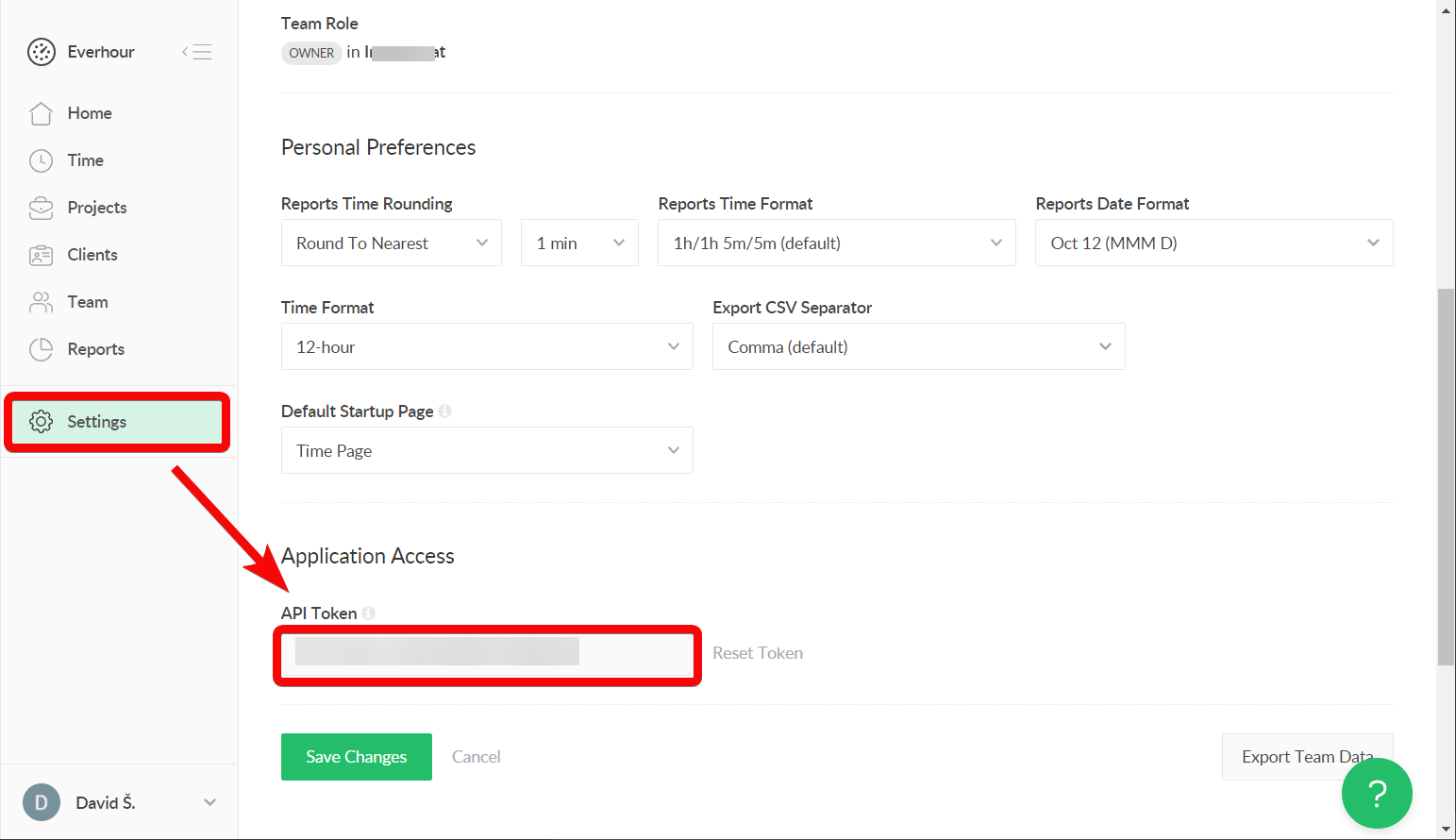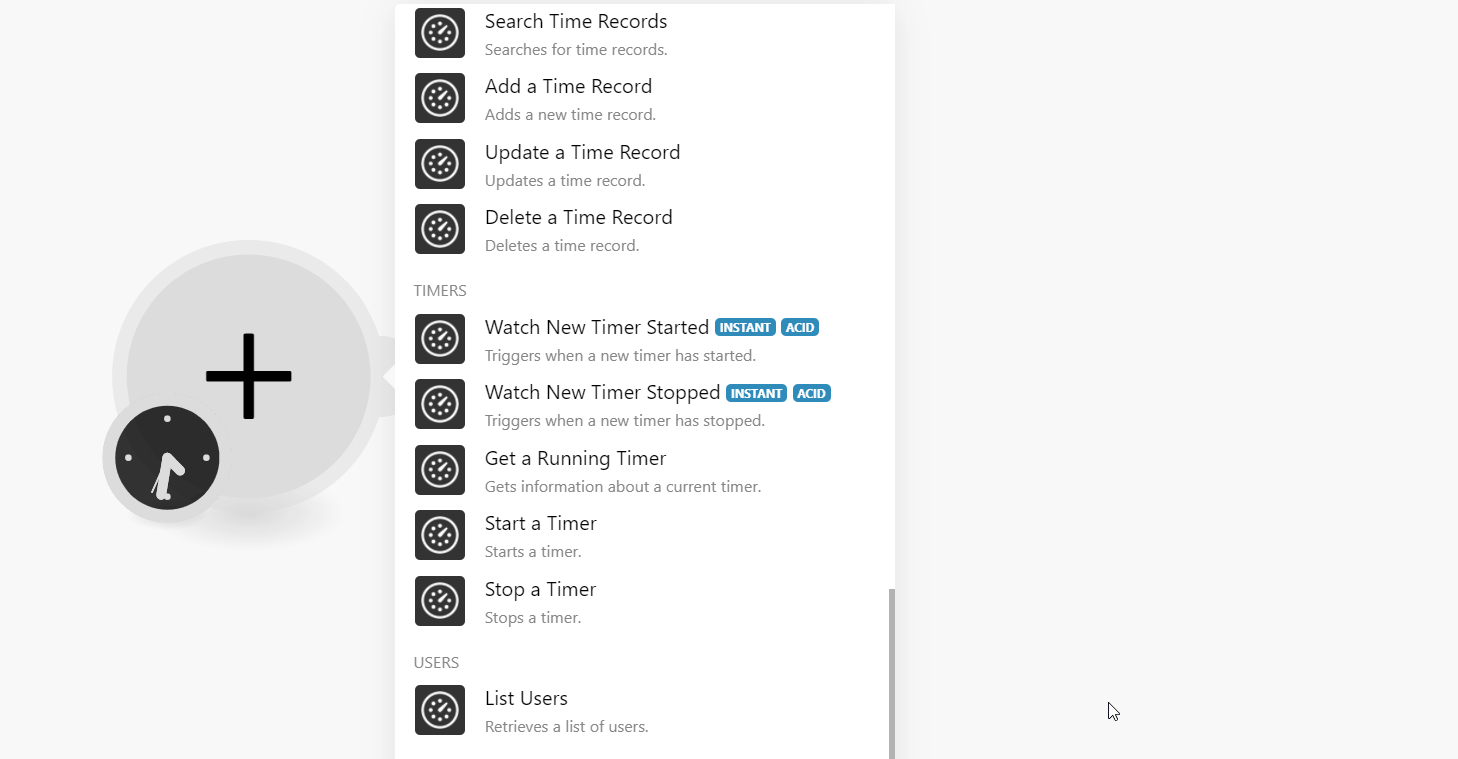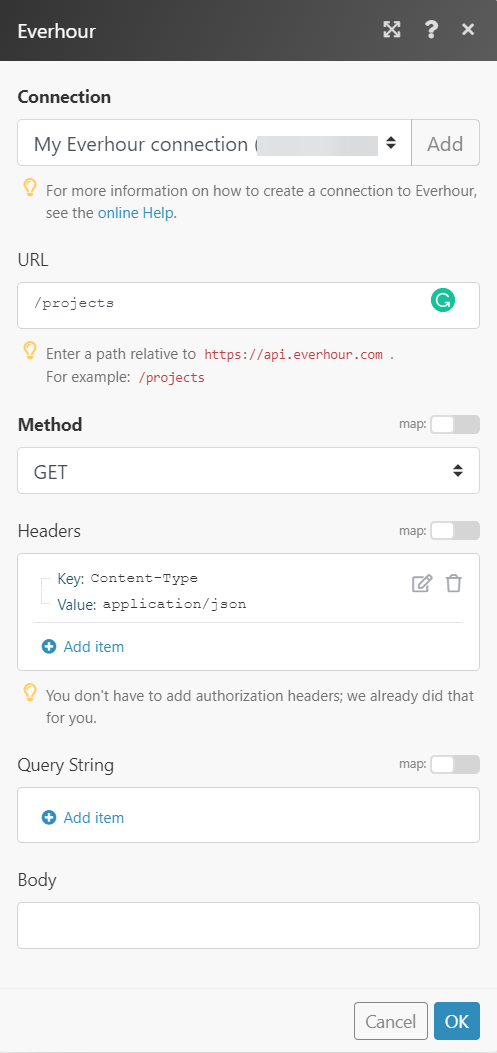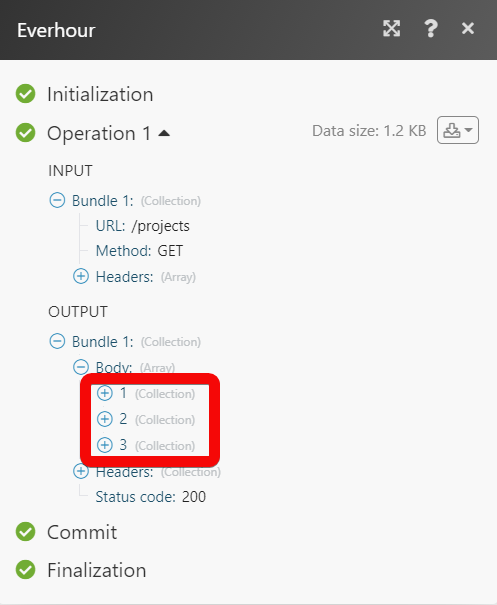The Everhour modules allow you to monitor, create, update, send, retrieve, and list the clients, projects, tasks, timer, time records, and sections in your Everhour account.
Prerequisites
-
An Everhour account – create an account at everhour.com/signup.
To connect your Everhour account to Boost.space Integrator you need to obtain the API Key from your Everhour account and insert it in the Create a connection dialog in the Boost.space Integrator module.
1. Log in to your Everhour account.
2. Click Your Profile Icon > My Profile. Copy the Access Token to your clipboard.

3. Log in to your Boost.space Integrator account, add a module from the Everhour app into an Boost.space Integrator scenario.
4. Click Add next to the Connection field.

5. In the Connection name field, enter a name for the connection.
6. In the API Key field, enter the API key copied in step 3, and click Continue.
The connection has been established.
![[Note]](https://docs.boost.space/wp-content/themes/bsdocs/docs-parser/HTML/css/image/note.png) |
Note |
|---|---|
|
Boost.space Integrator automatically creates a webhook in Everhour once you add an instant trigger to your scenario. |
Triggers when new clients have been created.
|
Webhook Name |
Enter a name for the webhook. |
|
Connection |
Search for a list of clients.
|
Connection |
|
|
Query |
Enter a keyword or phrase to search the clients that match the specified query. |
|
Limit |
Set the maximum number of new clients Boost.space Integrator should return during one execution cycle. |
Retrieves a client.
|
Connection |
|
|
Client ID |
Select or map the Client ID whose details you want to retrieve. |
Creates a new client.
|
Connection |
|
|
Name |
Enter (map) a name for the project. |
|
Projects |
Select or map the projects that you want to associate with the client. |
|
Business Details |
Enter (map) the details of the client. |
Updates a client.
|
Connection |
|
|
Name |
Enter (map) a name for the project. |
|
Projects |
Select or map the projects that you want to associate with the client. |
|
Business Details |
Enter (map) the details of the client. |
Deletes a client budget.
|
Connection |
|
|
Client ID |
Select or map the Client ID whose budget you want to delete. |
![[Note]](https://docs.boost.space/wp-content/themes/bsdocs/docs-parser/HTML/css/image/note.png) |
Note |
|---|---|
|
Boost.space Integrator automatically creates a webhook in Everhour once you add an instant trigger to your scenario. |
Triggers if the new projects have been created.
|
Webhook Name |
Enter a name for the webhook. |
|
Connection |
Searches for certain projects.
|
Connection |
|
|
Query |
Enter a keyword or phrase to search the projects that match the specified query. |
|
Platform |
Select or map the project platform. For example, Asana. |
|
Limit |
Set the maximum number of projects Boost.space Integrator should return during one execution cycle. |
Retrieves a specific project.
|
Connection |
|
|
Project ID |
Select or map the Project ID whose details you want to retrieve. |
Creates a new project.
|
Connection |
|
|
Name |
Enter (map) a name for the project. |
|
Type |
Select or map the project type. For example, Board project. |
|
Users |
Select or map the users associated with the projects. |
Updates a certain project.
|
Connection |
|
|
Project ID |
Select or map the Project ID whose details you want to update. |
|
Name |
Enter (map) a name for the Project. |
|
Type |
Select or map the project type. For example, Board project. |
|
Users |
Select or map the users associated with the projects. |
Deletes a certain project.
|
Connection |
|
|
Project ID |
Select or map the Project ID you want to delete. |
Searches for sections.
|
Connection |
|
|
Project ID |
Select or map the Section ID whose section you want to search. |
|
Limit |
Set the maximum number of sections Boost.space Integrator should return during one execution cycle. |
Retrieves a specific section.
|
Connection |
|
|
Project ID |
Select or map the Project ID whose details you want to update. |
|
Name |
Enter (map) a name for the Project. |
|
Type |
Select or map the project type. For example, Board project. |
|
Users |
Select or map the users associated with the projects. |
Creates a new section.
|
Connection |
|
|
Project ID |
Select or map the Project ID whose section you want to create. |
|
Name |
Enter (map) a name for the section. |
|
Status |
Select or map the status of the section. For example, Open. |
|
Position |
Enter (map) the section position in the project. For example, 2. |
Updates a specific section.
|
Connection |
|
|
Project ID |
Select or map the Project ID whose section details you want to update. |
|
Section ID |
Enter (map) the Section ID whose details you want to update. |
|
Name |
Enter (map) a name for the section. |
|
Status |
Select or map the status of the section. For example, Open. |
|
Position |
Enter (map) the section position in the project. For example, |
Deletes a specific section.
|
Connection |
|
|
Project ID |
Select or map the Project ID whose section details you want to delete. |
|
Section ID |
Enter (map) the Section ID you want to delete. |
![[Note]](https://docs.boost.space/wp-content/themes/bsdocs/docs-parser/HTML/css/image/note.png) |
Note |
|---|---|
|
Boost.space Integrator automatically creates a webhook in Everhour once you add an instant trigger to your scenario. |
Triggers when new tasks have been created.
|
Webhook Name |
Enter a name for the webhook. |
|
Connection |
Triggers when task time has been updated.
|
Webhook Name |
Enter a name for the webhook. |
|
Connection |
Searches for a list of tasks.
|
Connection |
|
|
Query |
Enter (map) the word or phrase whose tasks you want to search. |
|
Search in Closed Tasks |
Select whether you want to search for the closed tasks. |
|
Limit |
Set the maximum number of tasks Boost.space Integrator should return during one execution cycle. |
Retrieves a task.
|
Connection |
|
|
Task ID |
Select or map the Task ID whose details you want to retrieve. |
Creates a new task.
|
Connection |
|
|
Project ID |
Select or map the Project ID whose task you want to create. |
|
Name |
Enter (map) a name for the task. |
|
Status |
Select or map the task status. For example, Open. |
|
Labels |
Add the labels for the task. For example, New. |
|
Description |
Enter (map) the task details. |
|
Due on |
Enter (map) a date by which the task must be completed. See the list of supported date and time formats. |
Updates a specific task.
|
Connection |
|
|
Project ID |
Select or map the Project ID whose task details you want to create. |
|
Section ID |
Select or map the Section ID under which |
|
Task ID |
Select or map the Task ID whose details you want to update. |
|
Name |
Enter (map) a name for the task. |
|
Status |
Select or map the task status. For example, Open. |
|
Labels |
Add the labels for the task. For example, New. |
|
Description |
Enter (map) the task details. |
|
Due on |
Enter (map) a date by which the task must be completed. See the list of supported date and time formats. |
Updates a task estimate.
|
Connection |
|
|
Project ID |
Select or map the Project ID whose task you want to create. |
|
Task ID |
Select or map the Task ID whose estimate time you want to update. |
|
Total |
Enter (map) the total time estimated for the task in seconds. |
|
Type |
Select or map the estimate type. For example, overall. |
|
Users |
Select or map the users to whom the task is assigned. |
Deletes a task estimate.
|
Connection |
|
|
Project ID |
Select or map the Project ID whose task estimate you want to delete. |
|
Task ID |
Select or map the Task ID whose estimate you want to delete. |
Deletes a task.
|
Connection |
|
|
Project ID |
Select or map the Project ID whose task you want to delete. |
|
Task ID |
Select or map the Task ID you want to delete. |
Searches for time records.
|
Connection |
|
|
From |
Enter (map) the date from which you want to search the records that were created on or after the specified date. See the list of supported date and time formats. |
|
To |
Enter (map) the date until which you want to search the records that were created on or before the specified date. See the list of supported date and time formats. |
|
Limit |
Set the maximum number of time records Boost.space Integrator should return during one execution cycle. |
Adds a new time record.
|
Connection |
|
|
Project ID |
Select or map the Project ID for which you want to create the time record. |
|
Date |
Enter (map) a date on which you want to create the time record. See the list of supported date and time formats. |
|
Time |
Enter (map) the time to create the record. |
|
User ID |
Select or map the User ID for whom you are creating the time record. |
|
Comment |
Enter (map) the notes about the time record. |
Updates a time record.
|
Connection |
|
|
Project ID |
Select or map the Project ID whose task time record you want to update. |
|
Task ID |
Select or map the Task ID whose time record details you want to update. |
|
Date |
Enter (map) a date on which you want to create the time record. See the list of supported date and time formats. |
|
Time |
Enter (map) the time to create the record. |
|
User ID |
Select or map the User ID for whom you are creating the time record. |
|
Comment |
Enter (map) the notes about the time record. |
Deletes a time record.
|
Connection |
|
|
Project ID |
Select or map the Project ID whose task time record you want to delete. |
|
Task ID |
Select or map the Task ID whose time record details you want to delete. |
|
Date |
Enter (map) a date on which you want to delete the time record. See the list of supported date and time formats. |
|
User ID |
Select or map the User ID associated with the time record. |
![[Note]](https://docs.boost.space/wp-content/themes/bsdocs/docs-parser/HTML/css/image/note.png) |
Note |
|---|---|
|
Boost.space Integrator automatically creates a webhook in Everhour once you add an instant trigger to your scenario. |
Triggers when a new timer has started.
|
Webhook Name |
Enter a name for the webhook. |
|
Connection |
Triggers when a new timer has stopped.
|
Webhook Name |
Enter a name for the webhook. |
|
Connection |
Gets information about a current timer.
Starts a timer.
|
Connection |
|
|
Project ID |
Select or map the Project ID whose task timer you want to start. |
|
Task ID |
Select or map the Task ID whose timer you want to start. |
|
User Date |
Enter (map) the date on which you want to start the timer. See the list of supported date and time formats. |
|
Comment |
Enter (map) the note to start the timer. |
Retrieves a list of users.
|
Connection |
|
|
Limit |
Set the maximum number of users Boost.space Integrator should return during one execution cycle. |
Performs an arbitrary authorized API call.
|
Connection |
|
|
URL |
Enter a path relative to For the list of available endpoints, refer to the Everhour API Documentation. |
|
Method |
Select the HTTP method you want to use: GET to retrieve information for an entry. POST to create a new entry. PUT to update/replace an existing entry. PATCH to make a partial entry update. DELETE to delete an entry. |
|
Headers |
Enter the desired request headers. You don’t have to add authorization headers; we already did that for you. |
|
Query String |
Enter the request query string. |
|
Body |
Enter the body content for your API call. |

